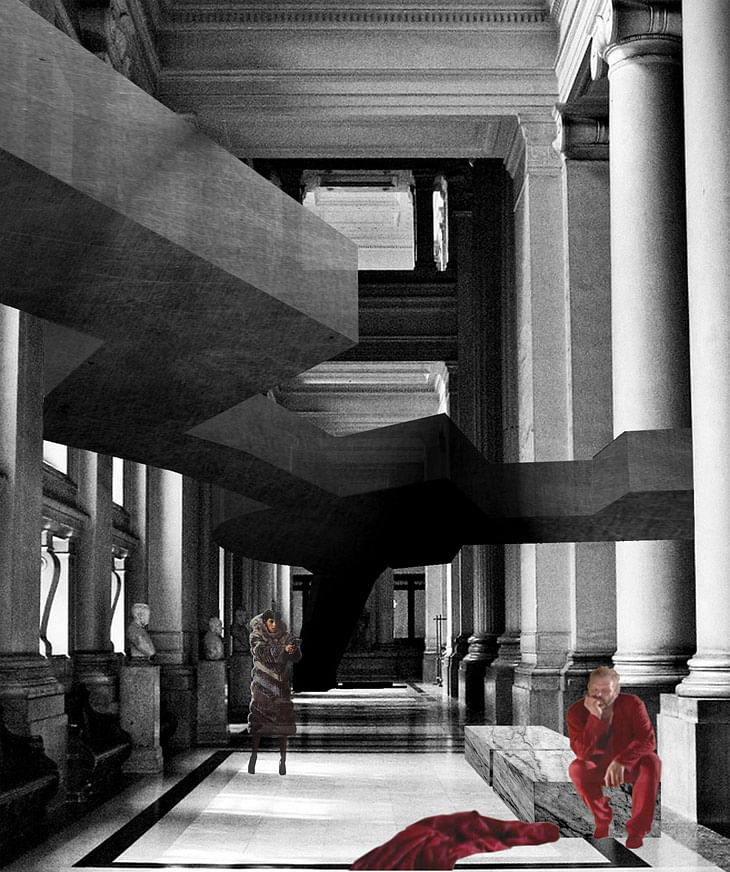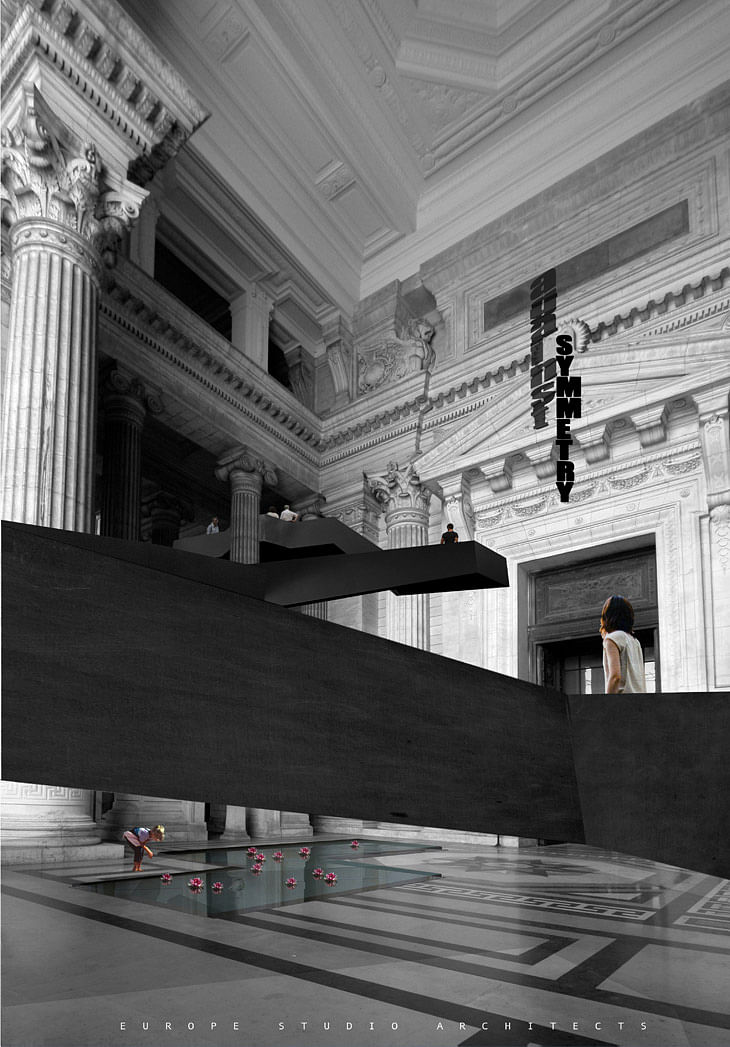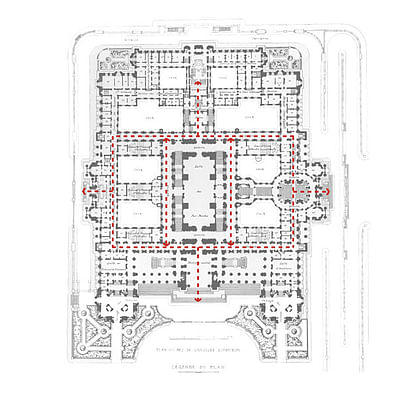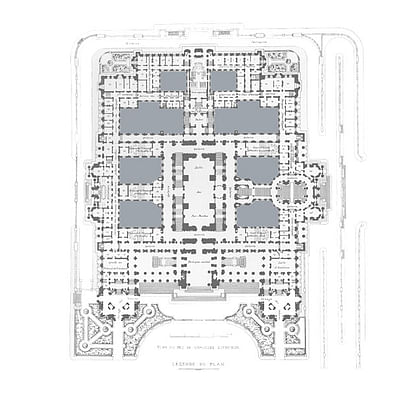'Against Symmetry' - Brussels Courthouse Redesign by Europe Studio Architects
By Bustler Editors|
Friday, May 20, 2011

Related
Greek/British practice Europe Studio Architects has sent us their entry 'Against Symmetry' for the Brussels Courthouse - Imagine the future! competition.
When the Belgian Buildings Agency and the Department of Justice recently announced the winners of the international ideas competition, this proposal didn't manage to fetch one of the top-scoring places, but we think it's worth sharing nonetheless.
The design team included the architects Constantine Cosmas and Stefanos Gkougkoustamos.
Project Description from the Architects:
Its emblematic presence, its imposingarchitecture and its monumental scale are some of the characteristics establishing it as one of the dominant elements of Brussels landscape and also a landmark visible to the city’s skyline. A distinctive example of the aesthetic architecture that orients and at the same time governs the area of its presence. The Law Court of Brussels or “Palais de Justice” as it is widely known, stands at the Galgenberg hill, a place that justice was dispensed during the Middle Ages where convicted criminals were hanged, offering a public spectacle; a place chosen by Léopold the 1st, as the area where his vision for the creation of the national symbol of Justice came to reality.
For its construction a large part of the city quarter of Marollen was demolished, and the inhabitants were force to move not just by the police, but by the architect as well. The eclectic style, the inflicting morphology in relation to the symmetry oriented by the dome and the peripheral internal courtyards, establish this building as a monument beyond its use as a Court of Justice, but also as the exhibit where the visitor observes its inside and surrounding, elaborates its details by having a continuous contact with its main program and the Judicial function of the building. Moreover, the strict program is also evident through the absolute symmetry in all three dimensions, giving the spectator the impression that he is also part of this grand monument, a sense projected through the definition of the monument as a meaning, oriented by the continuous movement inside the building halls.

The proposal for the future formation of the Courthouse moves in parallel to the existing frame and function of the building and proposes the re-establishment of the internal courtyards as open spaces, as it was originally presented to the Poelaertian early drawings. The cultural delicacy of an exhibition space or an art gallery drives the building to its completion, by unifying the monumental aesthetic with the minimalistic modernity of the exhibits inhabiting the proposed spaces. Throughout the integration of a new program - the one of spectacle, those courtyards stop to react as the symmetrical element of a grid, using them as the relieve areas of the much frequented corridors and various levels of the building. They obtain a new function, where the exhibits oriented by this space react as the display, just like the defendant, the opposing parties and the judges offer their own spectacle to an audience unable to interlink and react with them, as if they were the protagonists in their own play, having as a background the monument itself.
The approach to the main idea can be achieved by extruding the outline of the internal courtyards as a mass, exceeding the building levels, connected with a system of ramps and staircases that run throughout the entire building, where the visitor can observe the spectacle, but he is unable to interact, with it or the monument. He is considered to be the moving element in a scenery where the monument plays the role of the spectacle – from the perspective of the articulated courtyards and the circulation prototype, and in reverse for the user of the Courthouse, where the spectacle plays the role of the monument. An activity where none of them can interact with the double nature of the building at once, and the only connection is visual, just like Brodsky’s little man in the class tower, where he can observe and be observed, but cannot interact with his surroundings.

The “Palais de Justice”in Brussels is an iconic building. It is of architectural merit not only for the grandeur of its size and engineering (of the time) but also for successfully interpreting the relationship of power and hierarchy, fundamental notions of political and urban organization, and justice, cornerstone of the legal system.
It is evident that in order to negotiate the fore mentioned notions, the typology/figure ground of the building is developed based on a strict axis of symmetry, like most buildings of its time. Arguably, the strict balance imposed by that axis displays elegantly the idea of justice as one of equilibrium, a higher point of harmony, of order and stability.
What happens when the harmony, stability and order is disturbed? This ordered system (symmetry), the ordered wholeness makes the space look and feel grand, powerful but static. Justice is characterized also by dynamic qualities such as intensity, speed, and direction.
A principal design operation of the project is to introduce the “nexus”- a collection of connected urban spaces to stretch out (into the building) in juxtaposition of its spatial system - a “prototype”, the result of a different ordering system and of different scale.
This project attempts to break the ordered whole - of the spatial organization of Palais de Justice - and turn it into an architectural episode, a spectacle against its monumentality.
We propose a new independent circulation system through the building, which links all of the external courtyards. The system, manifested by ramps and staircases, invades the spaces of the courthouse (linking the courtyards).

The interplay between the new system and the courthouse spaces emphasizes the spaces volume and captures the spontaneity of a new architectural presence. The courtyards will be covered and will programmatically serve as contemporary exhibition spaces.
The project evolves through a series of diagrams that studied the way in which structure and space reflect the purpose of the building. Through the brief, yet substantial analysis, the organizing principal, that of symmetry as the spatial and structural ordering system becomes the focus of the project. In this case symmetry reflects a well organized, balanced system, the system of justice that is, and also its strict hierarchy reflected by the linear succession of spaces.

Flex of “nexus”
The introduction of the “nexus” - purely regarded as form in this case - to the courthouse’s spatial layout is an architectural gesture characterized by its dynamic potential, a gesture that becomes almost “violent”. The “nexus” manifested by a series of ramps-staircases and viewing decks demonstrates a dynamic movement towards the spaces of the courthouse. Consequently, another movement coexists with the first, from the spaces to the “nexus”. Both “nexus” and Courthouse create a dynamic amalgamation of architectural programs, circulation and experience of space.
The architectural act and the amalgamation both reveal the traces of reason (verbal) and the immediate experience of the space (visual).

Linking the program inside the building, the new circulation prototype attempts to challenge the geometry (symmetries) of the building layout and also attempt a portrayal of the human “figure” both thematically and in terms of scale within the Courthouse.
The “nexus”- the circulation prototype - is not meant to either resolve or enhance the spaces of the Courthouse. It is intended to function almost in isolation with the rest of the building in an attempt to connect the new use for the internal courtyards. The courtyards are stripped down from their current function and a new program is proposed, that of an art gallery space.
The courtyards are stripped down from their current function and a new program is proposed, that of an art gallery space. The circulation prototype becomes part of the art installations.

Project Details:
Project: Brussels CourtHouse, Imagine the Future, International Ideas Contest
Issued: The Belgian Building Agency
Project location: Brussels, Belgium
Year of study: 2010/11
Office: Europe Studio Architects
Team: Constantine Cosmas, Architect; Stefanos Gkougkoustamos, Architect
See also the floor plans for this proposal in the image gallery below.






Share
0 Comments
Comment as :